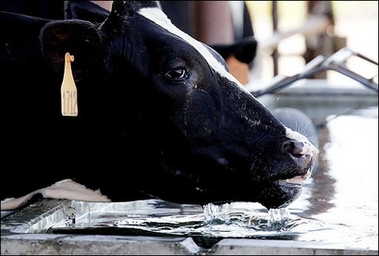Temperatures made a barely noticeable dip on the 11th day of 100-degree heat
Wednesday, but the stress on California's electric grid eased slightly, as did
the possibility of rolling blackouts.

A dairy cow drinks
water from a trough at the Zylstra Dairy Farm in Turlock, California. More
than 70 people may have died in California's record-breaking heat wave, a
state official said as temperatures appeared to
ebb.[AFP] |
The number of deaths believed to be caused by the heat rose sharply, reaching
83 since the heat wave started baking the state July 16. The heat and the
increased power use blew out thousands of transformers, and farmers reported
animals dying in the fields, and fruit and nuts scorched on the vine.
Hundreds of thousands of homes and businesses lost power at the peak, but
just a few thousand remained in the dark Wednesday. Still, the widespread
failures have left little opportunity for routine maintenance.
The coroner's office in Fresno County, which has reported 20 deaths as likely
heat-caused, had bodies stacked two to a gurney because there were so many.
Coroner Loralee Cervantes said that her staff was doing autopsies nonstop and
that decomposition of some bodies made the cause of death difficult to
determine.
Nineteen deaths were reported in neighboring Stanislaus County, and seven in
Sacramento County. In all, 18 counties reported heat-related deaths.
Near Mexico, the Border Patrol found the body of one illegal immigrant whose
death might be heat-related. It was unclear whether that death was included in
the heat wave death toll.
Border Patrol agents also discovered one seriously dehydrated immigrant who
was returned to Mexico and three women were hospitalized after being abandoned
in the locked trunk of a car for 90 minutes by a driver who ran away after
spotting a Border Patrol checkpoint.
Other states also attributed deaths to heat. Oklahoma said two people whose
homes lacked air conditioners were the latest victims there, bringing to 10 the
number of heat-related deaths since July 13.
An achingly slow cooling trend will cause highs to drop a few degrees by the
weekend in California, according to National Weather Service forecaster Jim
Dudley.
"We're seeing some relief coming, if you can call 105 relief," he said.
"We're inching away from this super hot air mass we've had over us, though it's
tricky. ... It's hard to get those things to move."
The record power usage on Monday and Tuesday had prompted power grid managers
to declare an emergency and warn of possible involuntary rolling blackouts. Now
the managers are waiting for cooler weather to begin assessing the damage and do
maintenance, said Gregg Fishman, a spokesman for the grid manager, Independent
System Operator.
"We have some balancing to do to allow as much maintenance as we can while
we're in a cooling spell," he said. The company is now focusing on restoring
power to those still without it.
More than 1,100 Pacific Gas and Electric Co. transformers were damaged by the
heat, leading to about 6,000 outages affecting over 1.2 million customers since
Friday, company spokesman Brian Swanson said.
The St. Louis area and the New York City borough of Queens slowly were
returning to normal more than a week after weather-related power blackouts.
About 51,000 customers around St. Louis still were without electricity,
according to Ameren Corp. Two storms July 19 and July 21 had knocked out power
to more than a half-million customers.
A sixth death was blamed on the storms and blackout; the man died Wednesday
in a fire that started while he was working on a power generator in East St.
Louis, Ill.
In Queens, the last of the 100,000 people affected by a 10-day outage had
their power restored, but the Consolidated Edison utility still warned of lower
voltage and occasional outages.
California's inland valleys have registered some of the highest temperatures
during the heat wave, with highs of around 115 and lows of about 90 degrees.
Farmers who face sun-baked crops and lower milk production are rushing
farmworkers to the fields well before dawn so they can get out by late morning,
when temperatures creep above 100.
Even with misters and fans to keep cattle cool, experts estimate as much as 2
percent of the state's dairy herd may die.
The surviving cattle are producing less milk, farmers said. Dairy production
in the state - No. 1 in the nation was down as much as 15 percent in the past
few days, according to the California Farm Bureau.
Though this is peak harvest time for fruits like peaches and nectarines, the
heat stops the ripening process. Tomatoes being grown for salsa, ketchup and
pasta sauces were found split in the fields, which will make them hard to sell.
It's too early to say what percentage of crops may be lost.
The heat might mean a slightly smaller harvest of wine grapes, said Karen
Ross, president of the California Association of Winegrape Growers. When
temperatures rise, vines stop growing to conserve water.
"They're just like people," she said. "They kind of shut down when it gets
this hot."